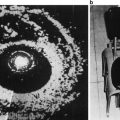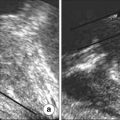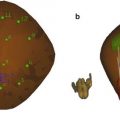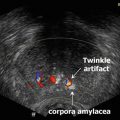Pre-testicular etiologies
Hypogonadotropic hypogonadism (congenital, acquired)
Coital Disorders (Erectile Dysfunction, Ejaculatory disorders) secondary to organic etiologies (diabetes mellitus, spinal injury, vascular/neurogenic, multiple sclerosis) and iatrogenic etiologies (RPLND, bladder neck surgery)
Primary testicular etiologies
Cryptorchidism (especially bilateral forms)
Infection or inflammation of the testes (Orchitis)
Testicular trauma
Testicular torsion
Varicocele
Gonadotoxic medications (including chemotherapy)
Radiation injury
Iatrogenic surgical injury (prior inguinal surgery)
Systemic diseases
Congenital etiologies
- Klinefelter’s syndrome (47, XXY)
- Y-chromosome terminal deletions (Yq-)
- Structural autosomal abnormalities
Post-testicular etiologies
Obstructive/sub-obstructive lesions of the seminal tract (vasa deferentia, seminal vesicles, ejaculatory ducts)
Autoimmune infertility (autoimmunity against spermatozoa)
Infections and inflammation of the accessory glands (seminal vesicles, prostate, epididymis)
Congenital bilateral absence of the vasa deferentia
Sperm Parameters
Semen analysis is a fundamental component of evaluating and defining the severity of male factor infertility [3, 6–8]. Semen analyses should always be conducted according to the WHO Laboratory Manual [3] in order to ensure standardization. The current standards for a normal semen analysis are defined in the fifth edition of the WHO Laboratory Manual, published in 2010, and can be reviewed in Table 2 [8, 9]. Classification based on semen analysis involves a wide variety of terminology, often misused in the public literature. A summary of the appropriate terminology is listed in Table 3 [6].
Table 2
WHO 2010 semen analysis parameters
Semen analysis component | Fifth percentile (95 % CI) |
|---|---|
Semen Volume | 1.5 mL (1.4–1.7) |
Total Sperm Number | 39 million (33–46) |
Sperm Concentration | 15 million/mL (12–16) |
Vitality | 58 % live (55–63) |
Progressive Motility | 32 % (31–34) |
Total (Progressive + Nonprogressive Motility) | 40 % (38–42) |
Morphologically Normal Forms | 4.0 % (3.0–4.0) |
Table 3
Terminology based on semen analysis
Classification | Defining characteristics |
|---|---|
Oligozoospermia | Sperm concentration <15 × 106/mL, total sperm number <39 × 106/mL |
Asthenozoospermia | <32 % progressively motile spermatozoa |
Teratozoospermia | <4 % morphologically normal spermatozoa |
Oligo-astheno-teratozoospermia | Disturbance in all three parameters |
Azoospermia | No spermatozoa in the ejaculate |
Cryptozoospermia | Spermatazoa absent from fresh preparation, but observed in a centrifuged pellet |
Aspermia | No ejaculate |
Leucocytospermia | > 1 × 106/mL leukocytes in the ejaculate |
Primary and Secondary Infertility
Primary male factor infertility is defined as infertility in men who have never been able to conceive a child. In contrast, secondary male factor infertility describes men who have previously conceived a child without assisted reproductive techniques but now is unable to achieve a successful pregnancy.
Obstructive and Non-obstructive
The importance of this classification lies in its prognostic value and the ability to then define the subsequent management for the patient. Obstructive etiologies frequently tend to have a good prognosis and, as described later, are often responsive to surgical interventions. Additionally, obstructive pathologies are best-identified using ultrasound imaging, and, as such, will be a major focus of the remainder of this chapter.
Evaluation of Male Infertility
Initial History
A complete and thorough history is the foundation of the evaluation for infertility. As there are a multitude of possible factors that may affect a patient’s fertility and sexual function, a thorough medical, surgical, pharmaceutical (both legal and illicit), social and developmental history may help allude to these, and therefore focus further investigations. Key components of a sexual and fertility include enquiring about the length of time trying to conceive, frequency of sexual intercourse, previous fertility including any pregnancy or children, and any previous treatments for infertility
It is vital that this comprehensive history should encompass both long-term and short-term factors. Semen production has a 64-day cycle with 10–15 days for transit. During this period any disruption in spermatogenesis can cause an abnormal semen analysis, hence it is vital to expound any of these short term factors. At the same time long-term factors are also important to establish, as childhood chronic illness can cause long-term fertility changes [10]. The basis of a thorough history and factors/components to ask your patient when beginning their infertility evaluation are summarized in Table 4 [7, 11].
Table 4
Components of a thorough history in the evaluation of an infertile male
Reproductive/infertility history |
Prior fertility/conceptions—current or previous partner, outcome |
Prior fertility evaluation |
Partner’s fertility history and evaluation |
Sexual history/Coital practices |
Sexually transmitted diseases |
Erectile function, lubrication |
Frequency/timing of intercourse |
Developmental history (onset of puberty, sexual characteristics) |
Past medical history |
Chronic illnesses |
Genital trauma |
Childhood history (cryptorchidism, torsion, midline defects) |
Prior infections |
Family history |
Infertility history |
Genetic conditions |
Substance use or exposure |
Prescription medication history |
Drug abuses |
Toxin exposure |
Prior surgical history |
Orchiopexy |
Retroperitoneal/pelvic surgery |
Herniorrhaphy |
Vasectomy |
Bladder neck/prostate surgery |
Spinal surgery |
Physical Examination
Physical examination is another key component of the evaluation of the infertile male. Special attention should be given to the genitourinary examination; this portion of the exam may help identify testicular and post-testicular etiologies of infertility. The penis should be inspected for hypospadias, and the scrotum for testicular size, presence of bilateral spermatic cords, and other gross abnormalities of the scrotum such as the presence of a varicocele. The key components of the physical examination are found in Table 5 [7, 11].
Table 5
Components of a thorough physical examination in the evaluation of an infertile male
General examination |
Body habitus (height, weight, body dimensions) |
Secondary sexual development (body hair, temporal balding) |
Gynecomastia |
Thyroid examination |
Abdominal examination (Hepatomegaly) |
Abdominal examination (Hepatomegaly) |
Evidence of chronic illness (diabetes, hypertension, vasculitis, neuropathy) |
Genitourinary examination |
Phallus (chordee, hypospadias, Peyronie’s) |
Testes (size, masses, infection) |
Epididymis (enlargement/induration, nodules, spermatoceles) |
Spermatic cord (varicocele) |
Vas deferens (presence or absence) |
Inguinal region (hernia) |
Prostate (nodules, infection, midline cysts) |
Genitourinary infections |
Labwork
Laboratory tests in the evaluation of the infertile male can be extensive. The initial laboratory test should be the semen analysis (Tables 2 and 3). These findings, in addition to those from the comprehensive history and examination will help direct further tests as required for a patient’s evaluation. In addition to the semen analysis, some key laboratory tests should include a complete blood cell count (to test for possible infection), renal and liver function studies, follicle stimulating hormone, luteinizing hormone and testosterone levels (to assess the hypothalamic–pituitary–gonadal axis), and a sexually transmitted infection evaluation. Additional laboratory test as may be ordered based on abnormal findings in the history, physical examination, and/or the initial laboratory test findings.
Imaging Modalities
While the ultrasound (transrectal, transperineal, and/or scrotal) remains the pillar of imaging for the infertile male, multiple imaging modalities are now available for the evaluation of an infertile male. Other modalities that may be utilized during the evaluation process include, but are not limited to, penile ultrasonography, abdominal ultrasonography, magnetic resonance imaging of the abdomen and pelvis, and PET scanning. A penile ultrasonography, using color Doppler, may be indicated if there is a history of Peyronie’s disease, penile fractures, and erectile dysfunction. All of these may decrease the patient’s sexual function, and henceforth cause decreased fertility [12, 13]. Abdominal ultrasound has a much more limited role in the evaluation process, as it is indicated to rule out associated renal abnormalities in patients with absent vasa deferentia. Occasionally, it may play a role in identifying renal or hepatic pathology as a contributor to infertility [12]. Magnetic Resonance Imaging has an emerging role in the evaluation of male infertility. It can provide a noninvasive alternative to traditional vasography, with or without endo-rectal coils, and is the gold standard for assessing the pituitary for possible adenomas causing hypothalamic–pituitary–gonadal axis. However it remains second line to ultrasonography for investigating possible causes of obstructive male infertility [12, 14]. As described in the remainder of this chapter, this imaging modality is an affordable, accessible, and versatile study that has an important role in a certain subset of infertile males.
Transrectal Ultrasound and Transperineal Ultrasound
Transrectal ultrasonography (TRUS) and transperineal ultrasound (TPUS) are important diagnostic tools in the field of male infertility. Historically diagnostic investigations of male infertility, such as vasography, were invasive, required general anesthetic, and had significant morbidity including iatrogenic stricture formation, vas obstruction, and radiation exposure. The vasograph has now given way to the ultrasound, and as the majority of the male reproductive system lies superficially, the ultrasound is an excellent non-morbid modality to evaluate the reproductive tract.
Stay updated, free articles. Join our Telegram channel

Full access? Get Clinical Tree








